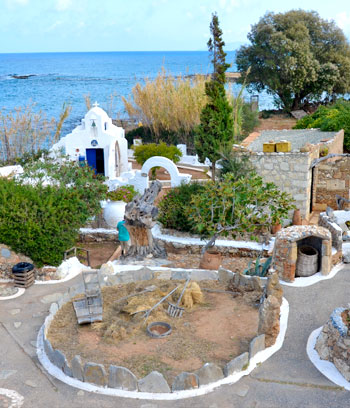 At the east side of Chersonissos Port, the Cretan Open-air Museum Lychnostatis is located. It is a lively, folklore museum that brings together different aspects of the Cretan tradition and the popular culture of Crete. The museum Lychnostatis is named after the supports on which the lamps (oil lamps), which used to lighten the houses, were placed.
At the east side of Chersonissos Port, the Cretan Open-air Museum Lychnostatis is located. It is a lively, folklore museum that brings together different aspects of the Cretan tradition and the popular culture of Crete. The museum Lychnostatis is named after the supports on which the lamps (oil lamps), which used to lighten the houses, were placed.
The Lychnostatis museum was created by the assistant professor of ophthalmology and collector – folklorist Giorgos Markakis. It was being built from 1986 to 1992 by all five members of Markakis’ family and three local workers in a volunteer basis. Since 2000, the Lychnostatis Museum has been incorporated into the Folklore and Educational Culture Networks of the Ministry of Culture.
The museum is extended in an area of 7,000 square meters and raw materials such as stone, wood and clay were used in its construction while mechanical means such as excavators, loaders and concrete mixers were avoided.
Four main collections are included in the museum. The first one is the Ethnographic Collection which is related to local occupations, local customs, social attitudes, lifestyle, legends and the other folklore- ethnographic elements.
The second collection is the Collection of Cretan Flora. This one is presented in a garden that surrounds the museum and thus the visitors can be aware of Cretan plants and herbs as well as fruit trees. In addition, stones and minerals of Cretan island in a variety of sizes, shapes and colors such as quartzite, marbles, onyx, stones with organic and vegetable fossils etc. are exhibited. Finally, ways of managing the plant materials and even ecological practices such as the green organic fertilization are presented.
The third collection is the Folk Art Collection in which works of famous self-taught Cretan artists are presented. Their works of art are made with materials such as wood and stone and those artists are proved to be followers of anonymous folk art. There is also a separate unit that is consisted of works from recyclable materials.
The fourth and last collection of the museum is the Pre-Industrial Technology Collection in which machines, used during the pre-industrial period such as the windmill, the oil mill, the carob mill and the press of aromatic plants, are shown and they are a distinguishing feature of agricultural know-how. In particular, within Lychnostatis Museum, there is a miniature building of the Cretan House, in which the rural and the urban ones are presented. There is also the mitato, which is the shepherd’s shelter in the mountains, a threshing floor, a wine-press, a cauldron and distillery for “tsikoudia” (alcoholic beverage “raki”). Workshops are also an important part of museum. There are many workshops such as the weaving and plant-dying workshop, the ceramic workshop, the carpenter’s workshop and the shoe-making workshop. In addition, it can be seen a bee’s and wax workshop, where honey and wax were produced, and a place in which aromatic plants and flowers are processed. Finally, there is an old school with things used for teaching in the past and a chapel of Virgin Mary.
Within the museum, it can be found an auditorium of 100 seats for providing audio-visual shows and seminars concerning the Cretan tradition and the natural environment of the island. There is also an open-air theater of 250 seats where cultural and artistic events are organized and a traditional café where traditional beverages and sweets are served. Lastly, there is a museum-shop in which handmade products are sold.
Should you need additional information please visit the site of the Museum Lychnostatis.